
Join the vehicle industry group, please add WeChat gasgoo88 and show your business card
TI can provide customers with more diverse options. On December 9, 2022, at the 2022 Third Hybrid Technology Development Forum organized by Gasgoo, Lu Jing, MCU product technical manager of Texas Instruments (TI) China, introduced that in response to the industry’s demand for high voltage, integration, and high safety in the field of electric control, TI launched the third-generation C2000™ DSP and ARM-based AM263X real-time MCU products, offering various pin counts, memory, and packaging options to meet various functional requirements such as integrated communication, functional safety, and information security, aiming to achieve higher performance and more economical real-time control effects.
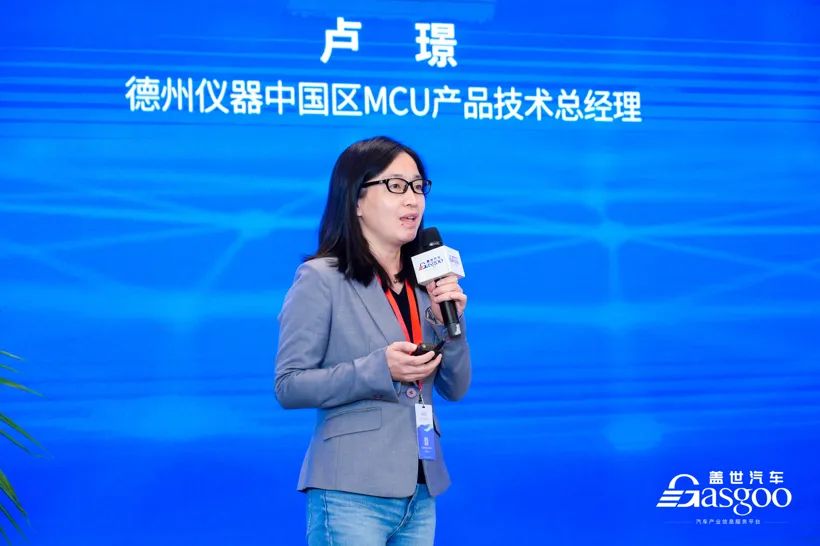
Lu Jing | Technical Manager of MCU Products, Texas Instruments China
The following is an organized summary of the speech:
Texas Instruments is a semiconductor chip company, and our business covers all aspects of chip R&D, manufacturing, testing, and sales. TI has over 8,000 analog and digital products, with nearly 100,000 customers worldwide across industrial automotive, consumer electronics, enterprise markets, and communications markets. Today, we will focus on TI’s MCU products in the field of automotive electrification.
TI entered China in 1986, and over the past 36 years, we have continuously enhanced our local service system. Currently, TI has an integrated manufacturing base in Chengdu, and R&D teams in Beijing, Shanghai, and Shenzhen. We also have product distribution centers in Shanghai and Shenzhen and nearly 20 sales and technical support branches to provide comprehensive support to customers in China.

Texas Instruments Automotive Electrification MCU Solutions
In recent years, the development trends of electrification, intelligence, and connectivity in the automotive industry have also brought many technical challenges. In the field of electrification, market trends require electric vehicles to have faster electric drive speeds, longer pure electric ranges, faster charging times, and higher power conversion efficiency, while also supporting power devices like SiC, with faster switching speeds for PWM frequency control, while ensuring the functional safety of the power system.
The intelligence sector demands stronger computing power and support for multi-sensor fusion. Connectivity requires vehicles to ensure data security and network security while being interconnected. Based on these technical trends, MCU products will have several common characteristics:
First is high performance, followed by information security and functional safety, which are becoming increasingly important, requiring MCU products to consider not only the main frequency but also the overall system’s functional safety.
Many guests today mentioned that the automotive industry is highly competitive, and one manifestation of this competition is that the entire product development cycle is getting shorter. As a semiconductor supplier, we need to provide a better software development environment and knowledge base to enable customers to quickly develop products and achieve better product reuse.
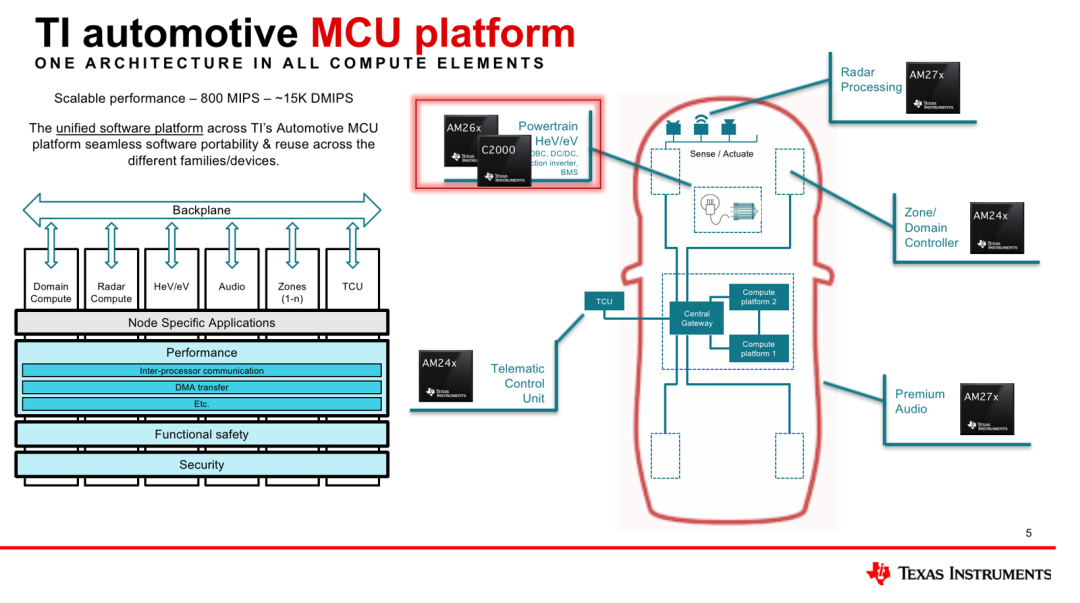
Image source: TI
First, let’s look at the MCU layout of the entire vehicle body. We have selected several MCU applications that might interest everyone. For radar processing in autonomous driving, TI has launched the AM27 series products, which include a pair of R5 lockstep cores and a C6000 DSP core. TI’s DSP has a history of two to three decades, so we excel in the performance of digital signal processing, which can effectively process radar signals. Meanwhile, TI AM27 is also very suitable for processing voice signals and can support the development of personalized products.
Additionally, the automotive industry is moving towards domain controllers, and the data transmission flow between each module of the vehicle body will increase significantly. Current LIN and CAN systems will struggle to meet this demand. In the long term, onboard Ethernet may soon be implemented, so TI has launched the AM24 series products, which can be used for vehicle body gateways or domain controllers.
The stars of today’s presentation are the C2000™ and AM26, which will be used more in electric control and electric drive fields. All TI products are based on a unified architecture, which will make the entire development process faster.
We divide the electrification process into two major parts: the first part is the electric drive, including hybrid systems, electric drive parts, and vehicle body air conditioning, etc.
The other part is the electric control, such as the charging OBC for plug-in hybrids and the DC/DC converters for high and low voltage conversions within the vehicle body. The common characteristic of these applications is real-time control, meaning the ability to quickly collect signals on the board and achieve real-time control through a series of calculations.
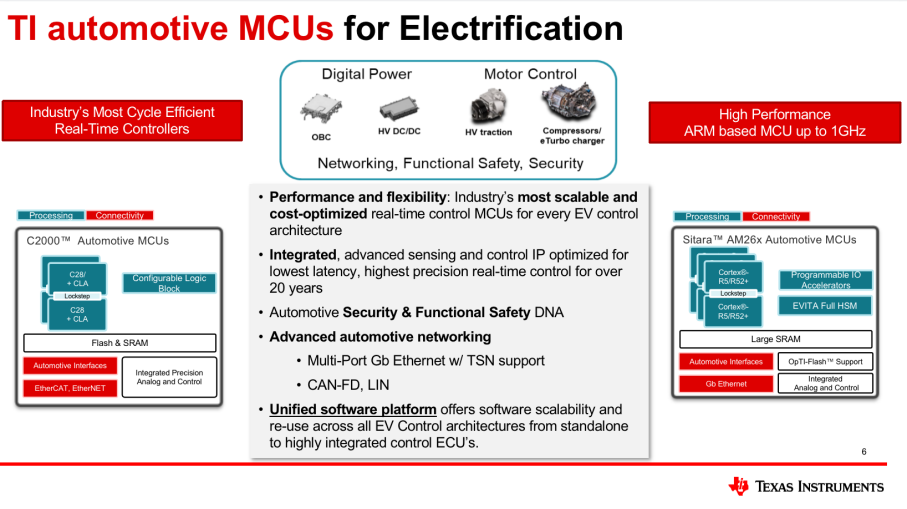
Image source: TI
For such real-time applications, TI has launched two series of products, the first being the C2000™ series, which is widely used in many manufacturers; the second is the AM26x series product launched last year, which will enter mass production this month.
Both products share the characteristic of having TI’s high-performance real-time control units, including high-throughput ADC modules, high-precision PWM modules, and high-speed comparator modules.
In response to the trends of functional safety and AUTOSAR, the AM26x products have integrated HSM hardware encryption modules, supporting certification up to ASIL-D level.
Now let’s look at the trends in the electric control field. Vehicles need longer ranges, thus requiring support for higher power. According to market information and forecasts, the market share of 11kW or 22kW OBC modules will increase significantly by 2030. To achieve such products, faster switching frequencies are needed, so we will use new power devices such as SiC, with control frequencies rising from the current hundreds of kHz to several hundred kHz, even up to MHz levels, at which point the CPU will need higher computing power, and the performance of peripherals will also need to be further enhanced.
TI’s product advantages are significant; from ADC sampling to control algorithms to PWM output, the entire loop control can be achieved within a microsecond, which is an outstanding performance in the industry. For the complex topologies of electric control products, we also provide high-precision PWM with up to 64 channels, helping customers achieve very flexible designs.
With AUTOSAR and ASIL-D support, customers can easily design using TI chips.
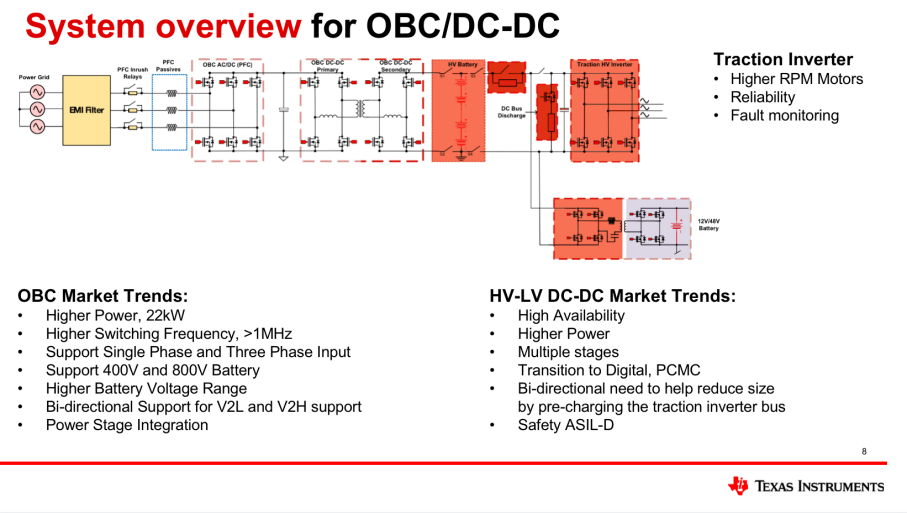
Image source: TI
Specifically, looking at the architecture of OBC and DC/DC on the PCB, the left side shows a charging device. The OBC typically has a power factor correction circuit in the front end that allows the product to better utilize grid efficiency, and then it will raise the voltage to 400V or even 800V to charge the power battery, which will drive the motor during further operation.
Since the vehicle body contains many devices such as speakers, seats, and lights, there are 12V or 48V circuits, thus requiring a conversion process from high voltage to low voltage, which needs to be achieved during the vehicle’s operation, making functional safety a top priority.
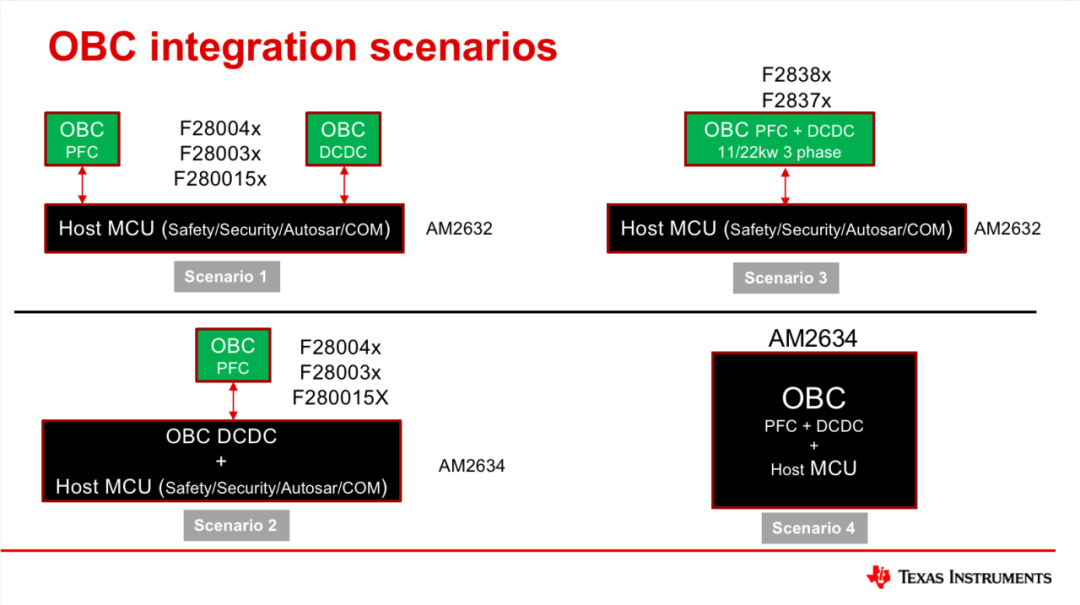
Image source: TI
Different manufacturers on the market have various methods for achieving functionality, which we have summarized into four application scenarios. One is currently common in the market, which is to use a single chip for PFC, which is a non-isolated circuit, and then use a second chip for the OBC’s DC/DC. Since this module needs to communicate with other components in the vehicle, a third MCU is usually required to run AUTOSAR, information security, or functional safety.
The second method involves using a more powerful MCU that combines the OBC’s DC/DC part with the main control MCU part, forming a dual-chip solution.
The third method involves some customers integrating the OBC PFC and DC/DC into one chip while using a main control MCU.
The fourth method is large integration, where all four functions can be placed on one chip.
TI offers all design flexibility, with high-performance products such as the quad-core 400MHz AM2634, as well as dual-core products like the AM2632. The C2000™ series also includes both quad-core and single-core products. For TI, we provide more choices, allowing customers to select solutions based on their specific situations.
For the conversion from high voltage to low voltage in DC/DC, we also have dual-chip and single-chip solutions. Integration is also a current trend, and we look forward to seeing more innovative architectures emerge.

Introduction to TI C2000™ & AM263x Chip Features
TI’s C2000™ has a history of over 20 years, used in the field of real-time control. In the automotive sector, the proportion of C2000™ in electric drive and electric control is quite high. Evaluating a chip can be approached from four aspects: first, whether it has sufficient capability and good performance to sample signals, including aspects such as channel count, throughput, and accuracy.
The second part is the processing capability.
The third part is control, including the flexibility of controlling the components on the board and the duration of control delays.
The fourth part is interfaces, assessing whether the number, types, and throughput of interfaces are rich enough to meet the needs of a wide range of customers. These four aspects can generally evaluate whether an MCU meets basic requirements.
So, where is the advantage of C2000™? Here, I would like to quote a statement from BYD’s Mr. Lu, who mentioned that when BYD innovates with DM-i, it is more about designing components from the user’s perspective. TI does the same; we need to think from the user’s perspective when designing chips, considering what functions we should provide to make their usage simpler and more convenient. C2000™ was designed with this perspective in mind.
In terms of computing power, it analyzes algorithms for real-time control fields and creates specific hardware instructions for specific calculations to improve processing speed. We also place a dedicated core to respond quickly to ADC signal interrupts, thereby reducing signal delays.
In sampling, we consider how to design ADCs to meet the synchronization requirements of different modules, achieving multi-channel synchronization. Additionally, to address potential sampling errors, we integrate hardware post-processing modules for automatic correction. PWM can also flexibly adjust time zones and phase shifts of various signals, allowing users to achieve various complex topologies. These are the initial intentions of TI’s chip design.
In addition to performance and real-time control characteristics, C2000™ has also done a lot of work for information security and functional safety, such as having anti-lock measures and encrypted boot for code protection. For encryption needs during information transmission, we also have corresponding hardware accelerators.
Currently, C2000™ has reached ASIL-B level functional safety certification, and in the future, we will develop chips that also achieve ASIL-D level certification. TI also provides functional safety diagnostic libraries, functional safety manuals, and other materials to assist customers in achieving system-level certification.
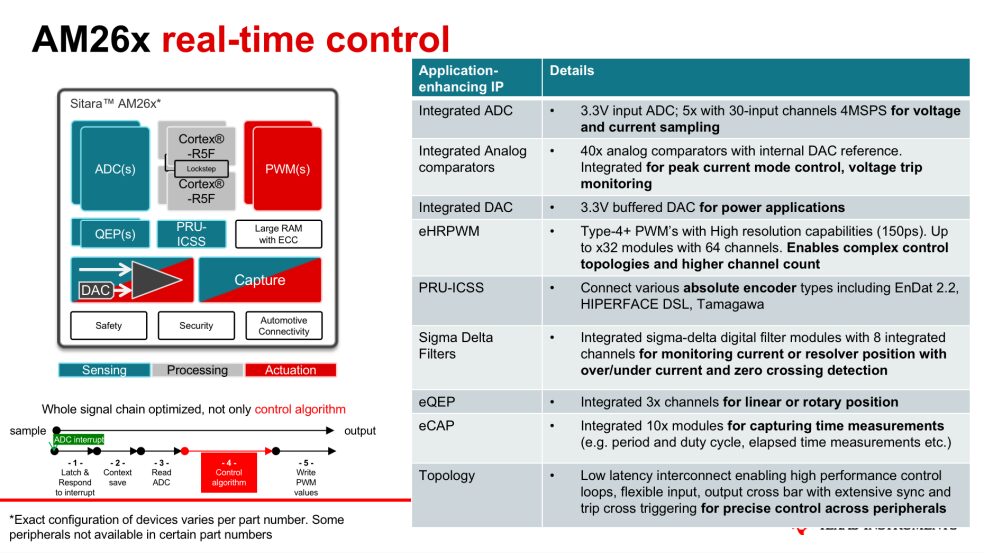
Image source: TI
TI’s AM26x series is more aimed at customers in the ARM ecosystem. The difference between AM26x and C2000™ lies only in the core, using the ARM R series core, with a maximum of four cores and a main frequency reaching 400MHz, with some products reaching 800MHz. All configurations are aimed at applications in electric drive and electric control.
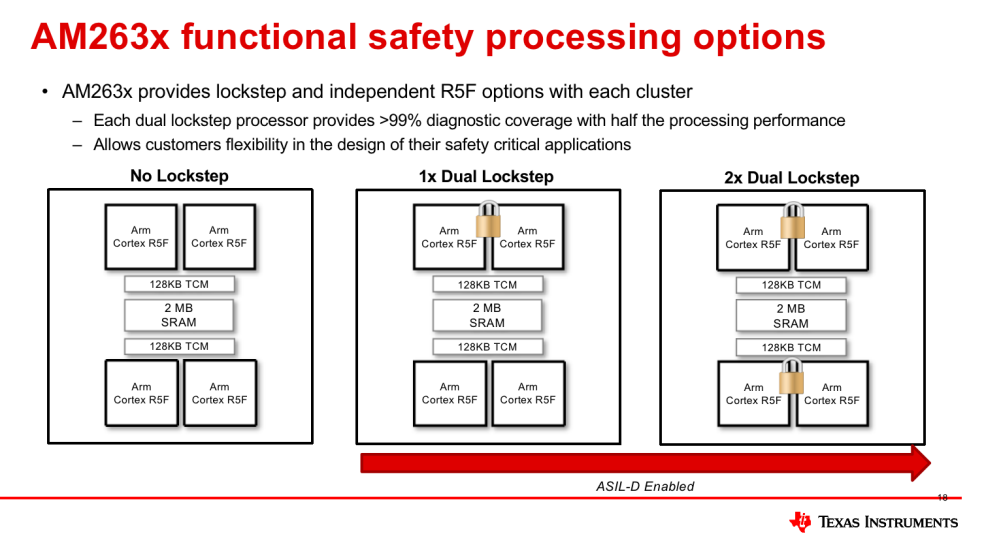
Image source: TI
The core can be flexibly configured, allowing users to choose based on their software architecture. Taking the middle architecture as an example, it uses a pair of lockstep cores to run functional safety and AUTOSAR monitoring, while the other two cores are used for motor control or power management. If some customers do not have functional safety requirements, they can use all four cores to enhance computing power.
All products in the TI AM26x series are hardware compatible, allowing customers to maintain consistent hardware design during product development, which can be flexibly configured through software to select cores.
In terms of functional safety, AM26x supports ASIL-D level certification, and its functional safety features are richer than those of C2000™. It includes functional safety mechanisms at the core level and memory access level, and it also incorporates numerous functional safety mechanisms on the bus to ensure system safety. Its information security can basically meet the automotive industry’s needs, supporting different algorithms, and customers can also add their own keys to achieve customized products.

Introduction to Reference Designs
In the future, there will be more and more 22kW products on the market. Additionally, vehicles are becoming large energy storage devices, thus increasing the demand for bidirectional charging in power supply design.
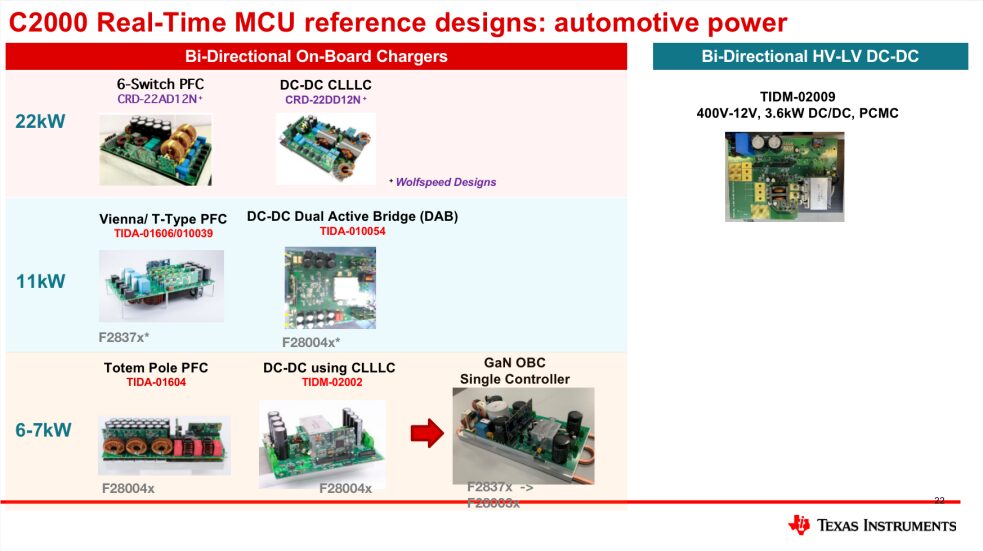
Image source: TI
This lists various reference designs for different power topologies. By entering the reference design number on the TI website, you can obtain the design materials and corresponding technical documents for the hardware board.
Earlier, we talked a lot about electric control, but electric drive also has some functional requirements for electric drive and DC/DC, including regenerative braking and how to improve the system efficiency of electric drive. For such applications, TI has also launched the reference design TIDM-02009.
TI’s mission is to hope that through continuous technological innovation, electronic devices can make people’s lives better. We also hope that through the continuous innovation of MCUs, TI can provide our industry with higher performance and cost-effective solutions, helping the entire industry’s electrification process go smoothly.
(The above content is from the theme speech “TI Empowers Automotive Electrification MCU Solutions” given by Lu Jing, Technical Manager of MCU Products at Texas Instruments China, at the 2022 Third Hybrid Technology Development Forum organized by Gasgoo on December 9, 2022.)
-END-
If you like this article, please give me a thumbs up

Hot Recommendations


——-Gasgoo Supply Chain Community currently covers quality management, intelligent manufacturing, electrification…
